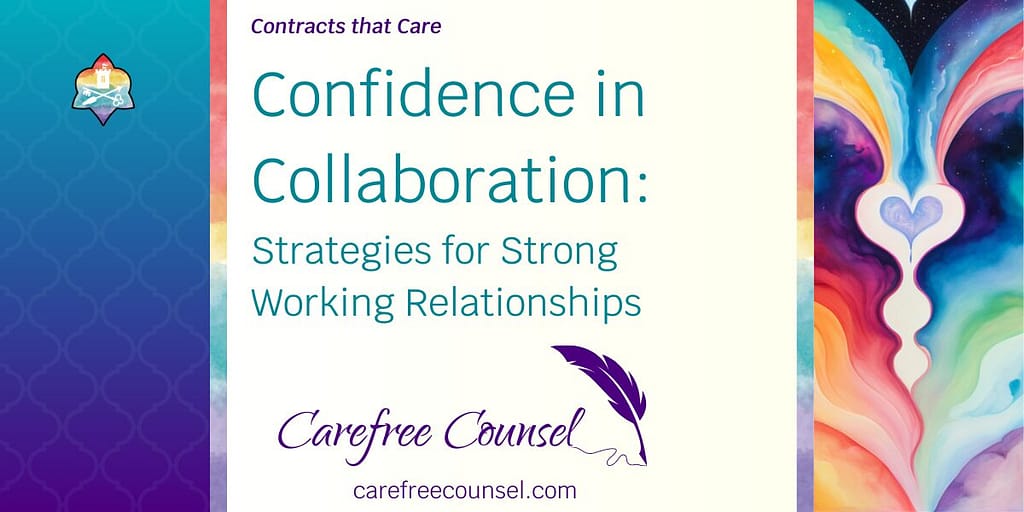
Connection and collaboration is a topic that I am passionate about. I love the synchronicity of bringing together different but complimentary skills, talents and ideas to create something greater than an individual could bring into being, working alone. The buzz of bouncing ideas of each other and having the opportunity to debrief with someone who totally gets you, the built-in support and accountability… collaboration really lights me up and I know I am not alone here!
Have you ever thought about your collaboration from a legal perspective though? When you are riding the wave of inspired connection, very few people stop to think about where their boundaries are in relation to this new relationship they are forming, to clarify what they expect to get out of it and what their obligations are beyond the basic to-do list, or to consider what kind of existence this relationship has in a legal sense.
In this blog, I investigate why it is so important to clarify the purpose of the collaboration, and look at what sort of things you both need to get clear on in order to have a truly successful collaboration, because before you can trust each other, you need to build mutual understanding.
What is Collaboration?
To begin, let’s get crystal clear on what we mean by collaboration. There are numerous definitions of collaboration, but today I am referring to collaboration in the following sense:
A cooperative arrangement in which two or more parties (which may or may not have any previous relationship) work jointly towards a common goal.
In many cases, collaborations between entrepreneurs grow out of friendships. People who like each other naturally supporting each other’s ideas, getting excited about how they can both benefit from working together and create something bigger and better than either of them can create alone. They don’t really stop to create a plan or think about the structure, they just start creating a business together, and unfortunately, that can prove to be the end of many friendships. As a lawyer it is something of a professional hazard in my job that I get to hear the horror stories of collaborations gone wrong.
Where do you start?
First, you need to start by discussing your business and strategic goals. Are they in alignment? Every collaboration needs an objective – an end goal. Think about what you are working towards. In every collaborative relationship, there will be shared goals and individual goals. Have you clearly identified these for each party and for the collaborative relationship? What is it that you want to achieve together and what do each want to get out of the collaboration as individuals?
Get clear on your values. What do each of you believe in and hold dear? What principles do you believe the relationship should be based on? Are your visions compatible?
If your future hopes, plans and dreams for your business are not compatible then resentment is more likely to arise. Either rethink the collaboration or ensure it is limited to a very well-defined short-term project.
What skills and resources does each business bring to the collaboration? Are these likely to clash, or complement and support each other? Have you got a clear idea about each party’s strengths and weaknesses?
Think about the power dynamics. Is there equality of size and capacity? A David and Goliath collaboration can work, but it requires extra care to ensure each party’s role is recognized as valuable and that the relationship is mutually beneficial.
How do each of you like to work? What is your operating culture? That is, the way you do things, your attitude to work. If one person loves structure, and strict compliance with policy and procedure while the other person prefers to wing it and make things up as they go along, your collaborative relationship is likely to be problematic. Be honest! Are your operating cultures compatible?
Successful collaborations are based on mutual dependency. That means you each need each other. Have you considered whether this collaborative relationship is both necessary (i.e. neither of you could achieve the goals that you have identified above without entering into this relationship) and sufficient (i.e. the collaborative relationship is capable of achieving those goals)?
It is also important to take some time to think about the systems, processes and procedures that will be required for the collaboration to operate smoothly. Have these been documented and are you confident they will be complied with? This could include record keeping, streamlining delivery, and management of client relations, among other things.
Have you thought about how the collaborative relationship will be managed? If there are teams involved, is there a clear and aligned management structure? Have you considered how you will manage mutual accountability?
If there are many people or larger organisations involved, are you clear on the governance structure? Do you need to nominate individuals who have leadership responsibility for the collaboration?
Don’t neglect the nitty-gritty details
Next, you really need to talk about money. What financial resources are each of you bringing to the relationship? This does not just mean a shared financial pool (which is a good idea for meeting expenses of the collaborative relationship). It is also important to consider whether each business can maintain and support themselves while working towards the collaborative goals. Are each of you in a sufficiently stable financial position to sustain your commitment to the collaborative relationship?
Do you have a clear understanding about how money will be handled during the collaboration? Will there be shared ownership of assets – like a joint account, or items that are purchased solely for collaborative purposes?
What about the intellectual property you create? How will that be owned? Will everything be shared 50/50 or will you each own what you create and licence the other to use it?
The answers to these questions are all going to be unique and individual to you, based on what you are creating and how, and on what your individual and combined goals and intentions are.
The biggest cause of breakdown in a collaborative relationship is lack of communication. Stop and think about the communication patterns you have observed in the relationship so far. Do you have any concerns? Are you able to communicate those concerns openly to the other people in the relationship? Do you feel heard? Can you each discuss differences of opinion calmly and negotiate win-win solutions? If you gloss over this issue or suppress your different opinions now, you are likely to regret it later.
Have you created a plan to ensure good communication continues to occur throughout the project? This can include things like scheduling regular meetings, accountability reporting and ongoing review of your goals, progress and work plans, including your collaborative agreement.
Plan for problems
Time to explore the risks involved in this collaboration. Risk can be both positive and negative, opportunity and threat! Risk is simply any area of uncertainty. What risks might have a positive effect on your collaborative relationship (for example, the risk that it will be successful beyond your wildest dreams)? What problems could that cause? Can you put an action plan in place that will help you exploit that risk if it occurs? What negative risks – potential dangers or loss – do each of you face if the collaboration fails? Can you put in place a plan to lower the likelihood of a negative risk eventuating or minimise the effects if something does go wrong?
Do you have a dispute resolution strategy? Many collaborations end up in expensive legal disputes because they didn’t put enough thought into solving problems BEFORE they arose. Figure out now what you are going to do if things start to go sour between you. Will you agree to try to negotiate and make legal action a last resort? Will you immediately cancel the agreement – what does that mean in terms of your commitments to each other and to third parties? Will you enlist the help of a trusted third party to mediate between you?
Have you created an exit plan? Do you know when the collaborative relationship is going to end? Is it on a specific date, when a specific goal is achieved, or simply when you no longer want to work together? How will you know that time has come and – more importantly – what happens next? It is very important to discuss what needs to happen in order to dissolve the relationship cleanly and without stress – and to do so at a time when everything looks rosy and you are still happily talking to each other!
Your exit plan needs to be detailed and cover all the little details so there are no misunderstandings. The more you plan for this at the start, the less painful the ending is likely to be.
Get super specific on expectations
Finally – and this is the biggest consideration of all – you are ready to map out the specifics of your collaborative relationship – your work plan. Lay out each party’s commitment in terms of resources, time and energy so each party knows exactly what it needs to do. Think about whether you have covered all aspects – “what, where, when, why, how and who” – for each obligation that you list. Getting up close and personal with all of the specific details of how you will work together now is essential to the success of your collaborative relationship.
Your work plan might need to be divided into phases, and should take into account the preliminary stages such as obtaining financial and legal advice and setting up the structures, procedures and policies, as well as the substantive details of the actual collaborative project. Is your work plan ready to go?
How I can help
Once you have worked through all of these questions, you will be in a great space for launching a collaborative venture, but there is one more thing to consider – and that is whether you want to write all of the details you have agreed on into a contract. A contract prevents conflict by making sure that there are legally binding consequences to behaviour that is in breach of the agreement. It is also much easier to sort out the kinds of questions or disagreements that can arise down the track if they are formally written out with extreme clarity, rather then contained in the memory of discussions or disjointed emails. If you would like to chat about a collaborative relationship, you might like to book a Collaborate With Confidence consultation, where we can talk about any other aspects of the relationship that concern you. You can also buy my Collaborate With Confidence Workbook to help you get very clear on what is important to you and how you want the relationship to unfold.

